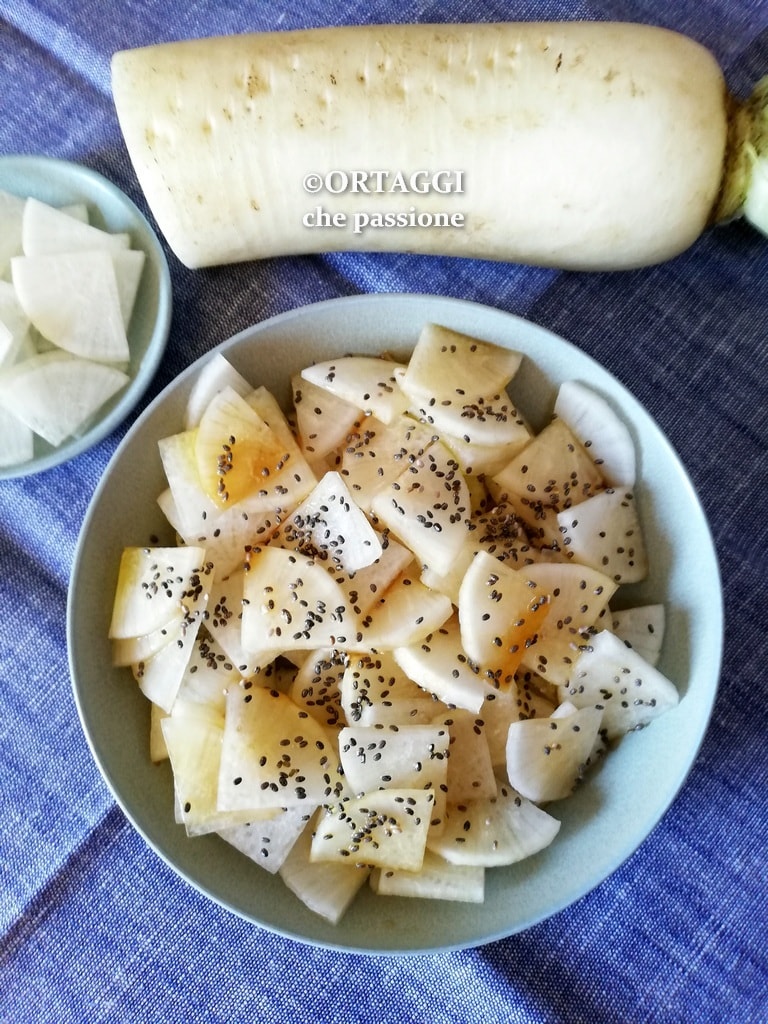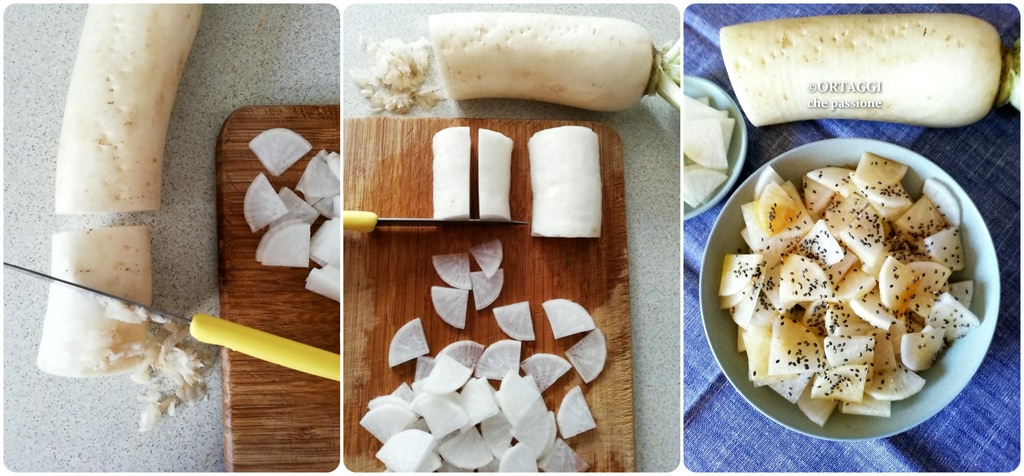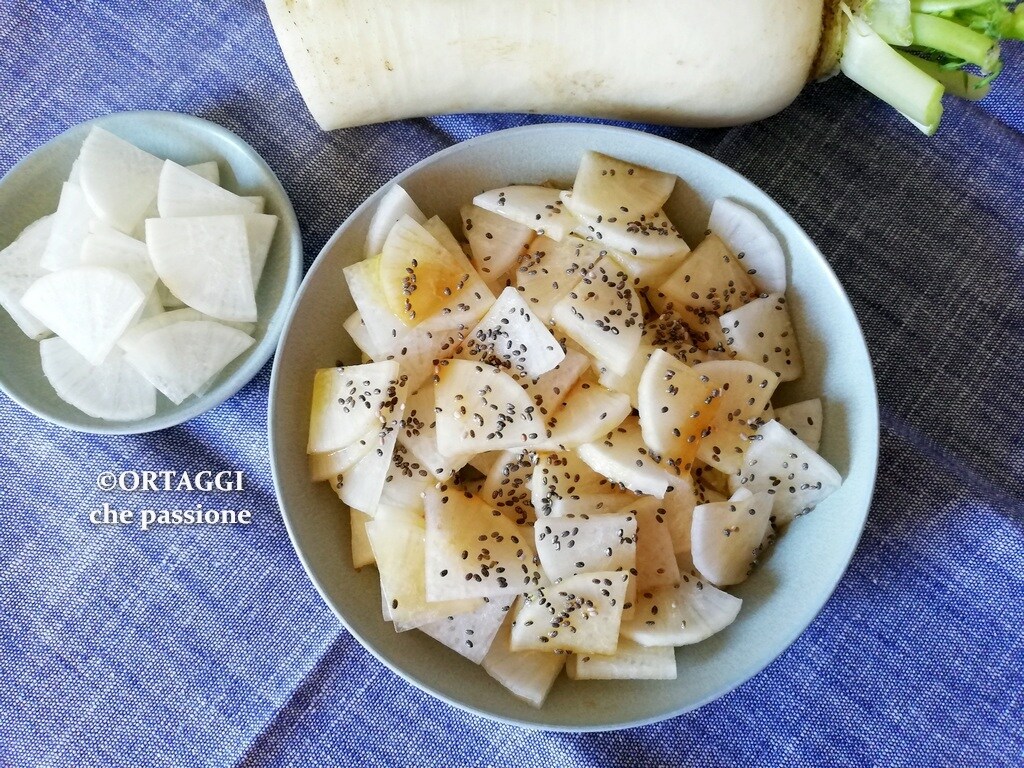Raw daikon in salad is an easy recipe to enjoy this little-known and rarely used vegetable in Italy. Raw daikon has a fresh and crunchy taste; its delicate sweetness blends with a slightly spicy note.
Nutritionist Linda Caracausi explains the properties of raw daikon: “It is the perfect purifying agent of traditional Chinese medicine. It’s a low-calorie white radish with an elongated shape and very good antioxidant and mineral properties, in fact, it contains potassium, calcium, magnesium, manganese and is recommended for dissolving excess fats and improving blood sugar levels, which tend to rise, especially after a carbohydrate-rich meal. It aids digestion, contains fibers that promote intestinal transit, and is truly a boon against cellulite. It also improves skin and bone health. It’s useful to curb appetite as an appetizer, both raw and cooked.“
Contraindications: excessive consumption of raw daikon can cause gastrointestinal disturbances like flatulence and a feeling of bloating.
SEASON of #daikon (also known as white or winter Japanese radish) – from September to February.
RECIPES with daikon

- Difficulty: Easy
- Cost: Inexpensive
- Preparation time: 10 Minutes
- Portions: 2
- Cooking methods: No Cooking
- Cuisine: Healthy
- Seasonality: Fall, Winter
- Energy 47.35 (Kcal)
- Carbohydrates 2.83 (g) of which sugars 1.50 (g)
- Proteins 0.72 (g)
- Fat 3.89 (g) of which saturated 0.76 (g)of which unsaturated 2.89 (g)
- Fibers 1.34 (g)
- Sodium 292.20 (mg)
Indicative values for a portion of 80 g processed in an automated way starting from the nutritional information available on the CREA* and FoodData Central** databases. It is not food and / or nutritional advice.
* CREATES Food and Nutrition Research Center: https://www.crea.gov.it/alimenti-e-nutrizione https://www.alimentinutrizione.it ** U.S. Department of Agriculture, Agricultural Research Service. FoodData Central, 2019. https://fdc.nal.usda.gov
Raw Daikon in Salad
- 5.3 oz daikon
- 1 tsp soy sauce (alternatively: salt and lemon)
- 1 tbsp rice oil (or extra virgin olive oil)
- to taste chia seeds (or sesame, cumin, or hemp seeds – OPTIONAL)
Tools
- Cutting Board wood
- Knife smooth blade well-sharpened
- Peeler
Raw Daikon Salad
PREPARE
Peel the daikon with a peeler or simply scrape its surface lightly with a smooth knife blade. The daikon skin is edible and rich in nutrients, so it is advisable to consume this root without peeling it. Make sure to wash it well to remove any soil or contaminants.
Cut the ends of the daikon and divide it as you prefer:
into STICKS
Divide the daikon in half to make it more manageable. Then, place one half of the daikon on the cutting board and make thin slices along the length of the root. Take each slice and cut it into thin strips to get the sticks.
into CUBES
After cutting the daikon in half, make slices along the root and then cut them into thin strips in one direction and then perpendicularly to get cubes.
into JULIENNE
Grate the daikon using the large holes.
into DECORATIVE SHAPES
Daikon lends itself very well to creating decorative shapes, such as flowers or leaves; make sure to use a stable cutting board and a sharp knife to ensure safe and precise preparation.

Place the cut daikon in a bowl and season with soy sauce (it has a savory taste, so no need to add salt), oil, and preferred seeds. Mix.

STORE raw daikon and seasoned
Raw daikon in salad is crunchy when freshly seasoned, while if left to marinate for a few hours (or days), it will soften more and more, especially if cut into julienne strips. So seasoned, it keeps for a maximum of 2 days.

